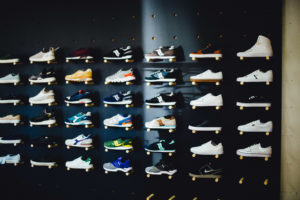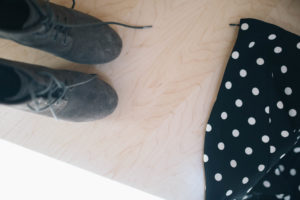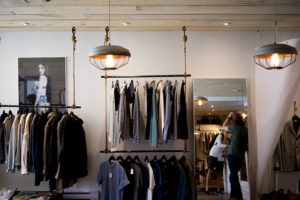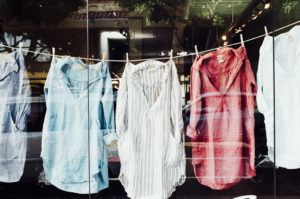Now, go and count them. I’ll be shocked if you didn’t underestimate the number. Many of the people I polled on this topic, through an informal question posted to my Facebook news feed of my 900+ friends, were at least a little surprised. The average number of shoes owned by women—19 of whom answered my survey—is 50. The average number of shoes owned by men—10 of whom answered—is 14.
Admittedly, my survey isn’t scientific. But still, you probably have more shoes than you need. According to a recent news poll, the average woman owns 19 pairs of shoes, and 15 percent of women own 30 or more pairs.
Why So Many Shoes?
So you may be wondering, why does anyone need so many shoes? And the Bureau of Labor Statistics says the average U.S. household spent $1,803 per year on apparel in 2016. That’s $600 per person for a family of three. No wonder people feel they never have enough money to Pay Themselves First!
 And we’re definitely spending more than we did in the past. The demand for walk-in closets has grown significantly in the past 40 years. And as the New York Times magazine noted, one out of every 10 Americans rent offsite storage. In fact, storage is one of the fastest growing segments of the commercial real estate industry.
And we’re definitely spending more than we did in the past. The demand for walk-in closets has grown significantly in the past 40 years. And as the New York Times magazine noted, one out of every 10 Americans rent offsite storage. In fact, storage is one of the fastest growing segments of the commercial real estate industry.
Everyone needs shoes and clothes, and indulgences in the occasional fancy heels or loafers is understandable. But the truth is our materialism is starving our Financial Freedom. By cutting some of the fat in our wardrobe, and reframing our needs appropriately, you’ll reach Financial Freedom much faster. Curbing our addiction to excess will help us buy back some of the time we traded for extra shirts and sandals we didn’t really need.
The Real Price Of Material Whims
Splurging now and again is one thing. But buying too many clothes is actually one of the worst ways we can spend our money for two reasons.

First, fashions change. Something that feels fresh and exciting today can be perceived as stale in the course of a year. And second, clothes wear out. And their value decreases with each additional wear.
You might argue that spending $10,000 on a nice, week-long vacation is a much more extravagant use of funds. But leading financial analysts and psychologists say that spending money on experiences—ones that we save for and enjoy—tend to make us happier than possessions in the long run.
Or perhaps we could think of it another way. As Dr. Tony explains, the most important thing money can buy isn’t a designer bag or a high-end watch. It’s actually time. Every material good we purchase requires a commitment of time, because we trade our time for money. So if you want to be free 10 years from now, instead of staring at a closet full of clothes you’re bored of that cost hours upon hours to create, shut your wallet. Love the possessions you have.
Curbing Retail Therapy
Unlike other material spending behaviors, buying new clothes or shoes feels like self-care. You’re getting what you need and deserve, “taking care of yourself” by not holding back on something you want. I identify with these feelings a lot. So I must always be vigilant, especially around the holidays when I’m shopping for others and can’t help but notice cute winter coats in store windows.
Many financial advisors suggest spending 3 to 5 percent of your income on clothing. So if you take home $4,000 a month, that’s $120 to $200 a month.
What if you could find a way to only spend 2.5% of your income—say, $100 a month if you take home $4,000 a month—on clothing? What would you do with those extra savings? If your goal is Financial Freedom, send that money to your Pay Yourself First account!
- Clean out your closet. There’s a popular book that’s out right now, called “Spark Joy.” The book centers on the idea that buying and keeping things you don’t love is a waste of energy. So try setting a goal of getting rid of 10 to 20 items of clothing or shoes you don’t love. Chances are you’ll realize how many wasteful purchases you’ve made over the years and how much old, undesirable attire has been weighing on you.
- Stick to your plan. When you set up your Freedom Plan, you allocated a certain amount to clothes. In the first part of Financially Fit Bootcamp, you determine what’s important to you and what you can spend for necessities and luxuries. When the money’s gone from your account, it’s gone. Wanting something new isn’t an emergency!
If you do want something badly, such as a $200 pair of shoes, set aside money from your everyday account to a short-term goals account. That process will also help you to assess whether those shoes are worth the sacrifice and the wait.
 Put online shopping on hold. The internet is your friend, except when ads for stuff you love pop up everywhere. The absolute best way I’ve avoided temptation is to go on a strict, online-buying sabbatical. I vowed, one day at a time, not to click a “buy” button. If going cold turkey is too extreme, here are some other effective online shopping strategies.
Put online shopping on hold. The internet is your friend, except when ads for stuff you love pop up everywhere. The absolute best way I’ve avoided temptation is to go on a strict, online-buying sabbatical. I vowed, one day at a time, not to click a “buy” button. If going cold turkey is too extreme, here are some other effective online shopping strategies.- Swap with friends. While some people love to scour thrift stores or consignment shops for great deals on clothes, I prefer to host or attend clothing swaps. At these events, held at restaurants or homes, everyone brings gently-used clothing to trade. It’s a fun way to get together with your peers. And it feels a little more intimate than buying clothing that’s been worn by someone you don’t know.
- Rent the expensive stuff. The one shopping behavior I still engage in online is renting nice dresses or gowns for formal events. I save a lot of money, and I still get to enjoy the fun experience of looking gorgeous and getting lots of compliments. The best part? I get to wear a brand new nice dress to every event (no repeats!). And that makes me feel like a total celebrity!
Keeping The Faith
Buying something you love on occasion is a joyful experience. But buying too many things you don’t need only stokes the craving to buy more. And that makes it that much harder to be Financially Free.
Don’t be like one of the 96 percent who are enslaved to a job, trading their time for money. Buying fewer things—especially clothes—will feel better in 10 years than being mired in a sea of cloth with no cash to spare.
The views and opinions expressed are those of the guest author and do not necessarily reflect the views and opinions of MindShift.money.
image credit: Bigstock/Maridav
Marisa Torrieri is an award-winning journalist and freelance writer specializing in personal finance, business, healthcare and technology. She has a master’s degree in journalism from Northwestern University and resides in Fairfield, CT. Her work has appeared in dozens of media outlets, including LearnVest, Forbes, The Washington Post, Business Insider, TIME and Health.com.

